Welcome back to Inside the Sketchbook — a series dedicated to exploring the methods, mediums and mindsets of the next generation of artists. In our next instalment of blog posts, we’re talking to more incredible, up-and-coming creatives who are making their mark on the world, through their sketchbooks.
Last but not least, we talked with Laura Page; after graduating from Falmouth University and delving into the world of design, she recently took the opportunity to step back from digital creation and rediscover her love of simply picking up a paintbrush.
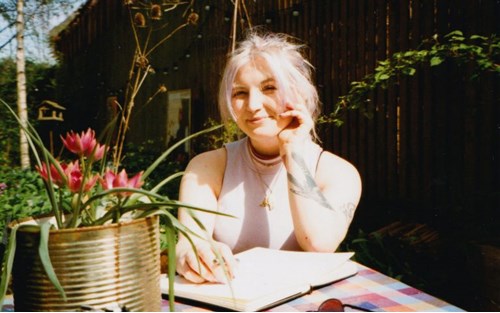
What’s your artistic backstory?
I’ve always drawn, pretty much my entire life. As a kid, I used to do fanart of Terry Pratchet characters and Mighty Boosh stuff in little sketchbooks. After developing a lot of my art in school, I went on to study Illustration at the Edinburgh College of Art and that was a really great experience for me. I was there for four years. First was a lot of traditional work — doing posters and tiny bits of branding — but it was such an open course, and because of this, it was a place where I developed this kind of quite specific, observational illustrative style. I’ve since branched out, completing a masters at RCA, where I got more interested in installation and pure poetry work.
Where does your love for poetry come into your work?
Whenever I’d keep sketchbooks, I’d add little sentences and words by my drawings. For a really long time I thought of them (the drawings and the words) as separate things. I thought, “I’ve gone to school for illustration, I’m trained in this, this is my lane”, whereas the writing I did almost because of a subconscious need to do it. But it almost didn’t feel like I was allowed. So a couple of years into my illustration degree was when I started making comics; using these lines and bits of poetry from my sketchbooks intentionally in my work, and my confidence built as the collection grew.
Now, I create poetry pieces in their own right, with no illustrations. They’re both doing the same thing — observing the world and recording it — but it’s funny how we think of them as two separate things. Different mediums sure, but equally serving the same purpose.
What’s your proudest artistic achievement to date?
Ah, such a tricky one! I do immediately think of the House Of Illustration residence in 2020 — it was an amazing opportunity to explore this niche area of illustration with poetry with a freedom I hadn’t had before. But on a smaller scale, I think about those moments when someone messages me on Instagram to say that my work made them think about their life experiences, and really feel something. When someone reaches out like that, it means so much to me. That’s when I feel like my work did what I wanted it to do. It’s very fulfilling in that way. Especially when I think back to being a student, and struggling with the idea of feeling selfish, making so much work about myself and my feelings. It’s nice to think people are getting something out of my work, and that I’m not just navel-gazing for my own enjoyment.
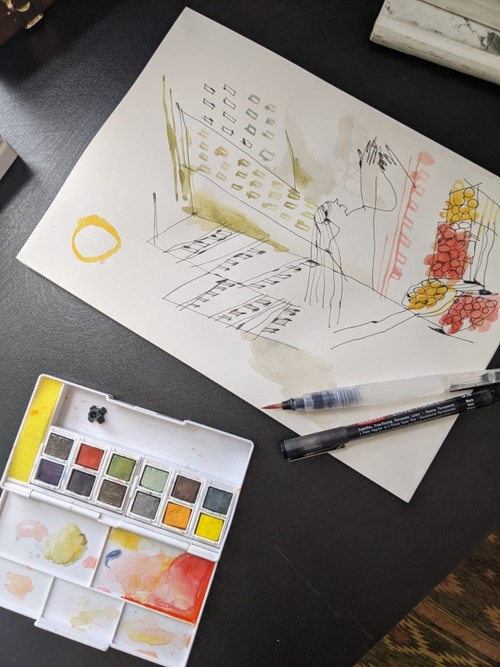
What do you want people to feel when they see your work?
A sense of connection. If people can see I’m trying to be really honest in it, and feel any kind of genuine connection, that’s really important to me. I don’t ever want to tell people how to think or feel, but whatever they find in it for themselves gives me so much joy.
Who are the characters in your work inspired by?
The everyday. Everyone around me. I’m obsessed with strangers and the idea that everyone has their own story or obsession. I’m always the person at the party asking all the questions because I’m interested in “what makes people people”. So when I’m drawing, you’ll always be able to pick out what is so unique to that person in the detail, and it’s that that I find so interesting.
The colour yellow is very apparent in your drawings, what does it mean to you and what is its importance in your work?
I’m obsessed with this idea of energy and motion in my drawing. I work very fast, trying to capture the sense of something or its energy, rather than really working intensely into it, because I want to capture it as accurately as possible but with as little as possible. So using yellow and bright primary colours helps capture that energetic feel. I’m also aware my drawings can be quite delicate, because I use lots of mechanical pencils and thin lines, so I’m almost balancing that out with the bold colours.
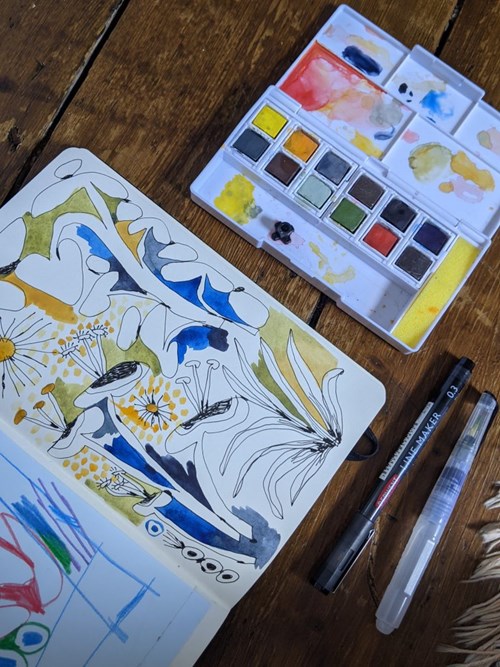
How does your poetry influence your art, and vice versa?
They are intertwined. They are almost like two sides of the same coin. They’re doing the same thing, but in some ways a drawing can capture it so perfectly, where in others you just can’t say it better than with a sentence.
How do you stay true to your original style?
My style has developed by ignoring a style. At uni, I was obsessed with having “the most unique style”, but in trying so hard I found I was actually just mimicking others. It was when I came to life drawing, that I actually started to set little rules for myself — like drawing really quickly, or using limited lines or colours — and by limiting myself in this way and ignoring what the end result was going to be, I weirdly developed this style which I really loved. And it was only by ignoring how it was going to turn out that I found it. It’s like I’ve created this mental toolkit, and sometimes the medium changes, but the approach is the same. I can ignore the finished product, knowing the tools will get me there.
Why is it so important to use quality materials?
You don’t want to admit it, but it is true that a craftsman is only as good as their tools, especially in terms of the breadth of materials. When I was a student, I might have been too scared to use some of the more unusual materials, and my work suffered for that. It was only when I explored, that I stepped into my own, and having the quality tools was such a big part of that. Things like choosing good paper, good pencils, it all affects how the finished product will look. Using quality materials that can do justice to what you’re doing is key.
What does Derwent mean to you?
I was talking to some friends recently, and we were saying how when you decide you want to be a serious artist at a young age, your first set of tools are your pencils, and all of ours were Derwent. I remember being so jealous of my friend, as she got one of those iconic wooden boxes of Derwent art supplies as a going away present when joining the illustration course. It seemed to say “I am dedicated to being an artist”, and that’s always stuck with me.
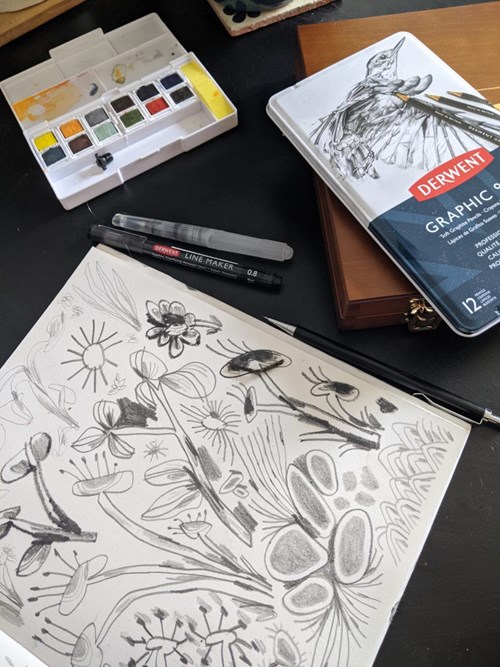
How has the Line and Wash Paint Pan Set helped you to best create the piece you’ve designed for this campaign?
Personally I loved the versatility of the set – I struggle with paints normally as I find watercolours too washed out and some gouache sets too thick and unwieldy. With the Line and Wash Paint Pan Set, I could pick precisely how opaque I wanted my colour, and could use the brush in a range of ways from precise fine lines to a gentle light wash.
Can you give us a three word review of Line and Wash Paint Pan Set?
Versatile, accessible and quality!
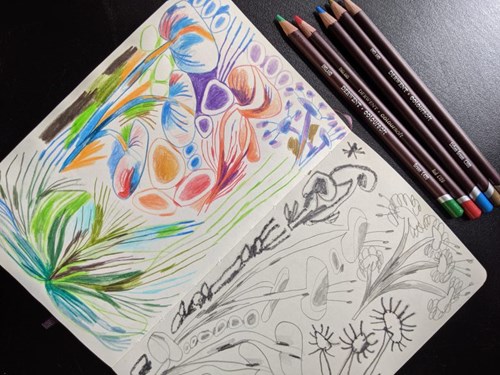
How do Derwent’s art supplies help you create the perfect piece?
What I’ve found so useful about Derwent’s art supplies is that each piece used is true quality – you can tell each item has been designed by those who truly know and understand what working artists and illustrators need. I also love the way the supplies complement each other; it’s been really enjoyable seeing how the Line and Wash Paint Pan Set combines with Coloursoft and Procolour pencils, and playing with the combination of Graphitone, Graphic and Precision Mechanical pencils.
Thank you for Peony for taking some time out of her day to speak with us. Stay tuned to our Inside the Sketchbook series, as our talented line up of up-and-coming artists tell us their stories and unpack their work.